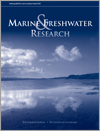Marine and Freshwater Research
Volume 72
Number 10 2021
Stemming the tide of wetland loss through a Declaration of Rights for Wetlands has superficial attraction. However, difficulties with defining what a wetland is and confusing human rights with ecosystem rights suggest there are more problems than opportunities inherent in such a Declaration. Using existing legal and governance mechanisms more effectively would be a better approach.
We reply to the response of Bridgewater (2021) to Davies et al. (2021a) by noting that the proposed Universal Declaration of the Rights of Wetlands specifically identifies wetland rights and stakeholders and complements and supports existing conservation and management approaches, and that legal rights have already been granted to non-humans, including wetlands. We concur on the importance of weaving Indigenous and local knowledges with other knowledges.
A primary goal of the A$13 billion Basin Plan is to conserve threatened species, yet Flow to Nowhere finds that this has been only partially achieved. Although some species benefit from environmental water, many others are missing out or going unreported. The Basin Plan should shift from ‘just adding water’ and, instead, focus on increasing reporting and community-led restoration.
This study explored the perspectives of marine fisheries stakeholders in a climate hotspot (Tasmania, Australia) of fisheries preparedness for climate change and creating a more sustainable and resilient system that is adaptive to climate change. The obstacles preventing fisheries adaptation to climate change and the changes necessary for future improvements to incorporate climate adaptation into fisheries and fisheries management are discussed.
We used acoustic telemetry data of 51 Port Jackson sharks over 8 years to examine temporal variation in their use of breeding aggregation sites. Males and females showed variation in residency length over the breeding season. Individuals typically showed 24-h periodicity in site use, but exhibited variation in the time of day that they were present. These data suggest that individual variation in residency may mediate competition among individuals.
The population connectivity of freshwater fish that use marine environments for growth is often highly complex and varies greatly between species. Yet, despite this, these species often remain critically understudied, hampering current conservation efforts. This study characterises the genetic connectivity of three such species found across the Victorian coast: common galaxias (Galaxias maculatus), tupong (Pseudaphritis urvillii), and Australian grayling (Prototroctes maraena). We show that each species exhibits unique patterns of genetic connectivity, helping inform best practice management for maintaining connectivity between populations within each species.
This study examines the hydrological factors that influence fish movements in an unregulated, perennial river and compares these behavioural responses to populations from regulated river systems. Our findings suggest that fish in perennial, highly connected rivers may not need to move as frequently as those in more regulated or intermittent systems, which may make it challenging to define generalisable environmental flow rules for informing river management.
Globally, riverine fishes are imperilled by flow regulation and fragmentation. We integrated otolith and water chemistry to determine the influence of natal origin and movement on the population dynamics of golden perch (Macquaria ambigua) in the regulated Murray River. Our study revealed golden perch collected in the lower Murray River were progeny of spawning in either the Murray or Darling rivers (a major tributary), and that the movement of juvenile fish substantially influenced population structure.
This study analysed the combined influence of river flooding and rotational grazing of cattle on water quality of floodplain lakes of the Middle Paraná River. Our results showed increased concentrations of nutrients and values of turbidity in relation to cattle presence. The flood improved the water quality through washing-out and dilution. Moreover, the intrinsic capacity of floodplain lakes for self-purification was enhanced after the flood. This highlights the importance of maintaining the river–floodplain connectivity to attenuate the effects of livestock on water quality.
As sessile communities develop, the structural complexity increases via growth and overgrowth constrained by space limitation, creating habitats for the associated mobile fauna. Using marine fouling communities, we observed that along succession such communities showed a biomass increment and an increase in more physically complex sessile organisms. These changes were followed by the associated mobile fauna, increasing in abundance and biomass, and changing in composition at later successional stages.
Within East Africa, and especially Kenya, the effects of deforestation and expansion of agricultural lands are progressing. This study investigated land use v. altitudinal shifts in the functional composition of macroinvertebrates within the Mount Elgon catchment in western Kenya to see which driver shapes the patterns of macroinvertebrate composition. A lack of significant interactions between elevation and land use indicated that the elevation gradient played a greater role in influencing the composition of macroinvertebrates in these streams.
The performance of simple mathematical models was evaluated to predict total dissolved solids (TDS), biochemical oxygen demand (BOD) and nitrate (NO3–) in a reservoir. These models were compared with a two-dimensional model and real observations. The findings suggest using such simple models for screening/feasibility studies and modelling water quality in multi-dam systems at the watershed scale.
Knowing how cave lithology influences the benthic macroinvertebrate fauna is important for conservation and management of subterranean aquatic systems. We aimed to test whether there are differences in the environmental factors and EPT assemblages from caves of two different lithologies, and rephrase the last sentence as follows: Our results showed that cave lithology influences water chemical and physical parameters, thus supporting different EPT communities. Lithology has an influence on the water chemical and physical characteristic, supporting different communities in each different lithology.





